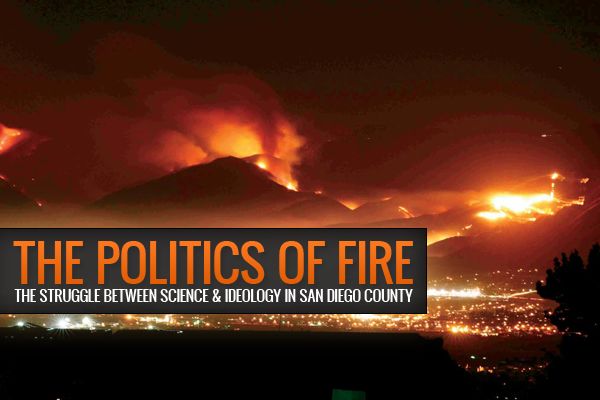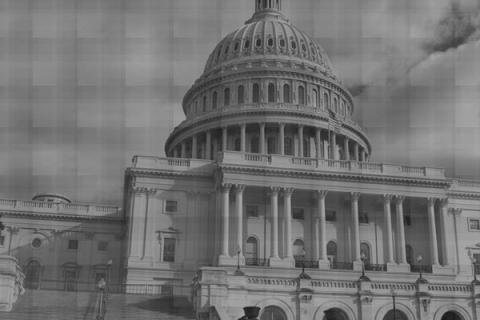“We have allowed things to grow that turn into green. As you know, or may not know, 200 years ago our back hills were covered in redwood trees. Well, lumber companies came in and cut them all down. And they replaced those with pine trees.”
- Supervisor Bill Horn, January 7, 2003, San Diego County Board of Supervisors meeting.
(Historically, redwood groves have never existed in San Diego County. The most southerly grove is in Big Sur, 400 miles to the north.)
The following article is a serialized story of the decade-long effort to convince intransigent government officials in San Diego County that science matters and that the region’s native chaparral ecosystem has value. In the name of fire protection, the county attempted to establish a plan that could have allowed it to clear tens of thousands of acres of native habitat without proper oversight as required by the California Environmental Quality Act (CEQA). The story is timely because of the current politicization of science in the United States and the impact that process can have on public policy. The story also provides valuable lessons to activists dealing with the enforcement of environmental law.
This is part I of VI
Click here for Part I of The Politics of Fire: The Struggle Between Science and Ideology in San Diego County
Click here for Part II of The Politics of Fire: Academic Nonsense
Click here for Part III of The Politics of Fire: Huge Fires are Natural
Click here for Part IV of The Politics of Fire: Denying the Science
Click here for Part V of The Politics of Fire: It Gets Worse
Click here for Part VI of The Politics of Fire: This is Not it
Click here for Part VII of The Politics of Fire: Attempting an End Run
Part 1: Get Rid of the Evil Brush!
Despite dedicated efforts by many in the conservation and scientific communities to help the public, government agencies, and political leaders understand that the West’s native shrublands provide important watershed, biodiversity, and cultural values, tragic misunderstandings persist. These ecosystems are frequently considered not only worthless, but an “evil menace” due to their inherent flammability. Hence, many advocate that shrublands should be systematically reduced or eliminated through mechanical clearance or prescribed burning. Dense stands of chaparral are falsely seen as “unnatural” and in need of mitigation. Old-growth stands of manzanita and chamise that have not burned for decades are viewed only as dangerous concentrations of fuel rather than the increasingly rare plant communities they represent. Changing such perspectives has been incredibly difficult and frustrating for those who understand the importance of conserving native plant communities and the benefits that come from such preservation.
Why has the task proved to be so challenging? While science and logic can be effective when first developing objective policy or forming new opinions, it is often ignored when favored paradigms control the conversation. These paradigms can be a product of prior learning, ideology, or what Eckhart Tolle has so eloquently identified as the ego’s “pain-body,” old but still influential emotions shaped by unresolved, painful experiences. When these paradigms are challenged, arguments can be seen as personal attacks because believers become emotionally and/or professionally committed to the paradigm’s acceptance. It has in effect become their “intellectual child.”
When it comes to convincing others of the value of native plant communities, the tendency for some to see humans as separate from nature adds to the difficulty, especially when native ecosystems are seen as the source of fires that threaten lives and property. “Nature” is the problem, not us. Consequently, nature becomes the “other” that needs to be dealt with.
Blaming an entity beyond ourselves for a particular problem has been a common strategy throughout history, allowing leaders and those who follow them to ignore the real issues. Diane Conklin, a community activist in San Diego County, addressed this behavior pattern during a public hearing on the county’s proposed massive native vegetation treatment program. She testified, “Don’t drag the suburban sprawl out into the chaparral and say, ‘Oh my God, we have fuel out here!’”
After working diligently for more than ten years to help both the public and government agencies see the value in shrubland ecosystems and have a greater appreciation for the complexities of wildland fire as it relates to both natural and human communities, we have seen a significant amount of progress. However, there remain entrenched belief patterns that frequently frustrate our educational efforts. Consequently, if we intend to change the way native shrubland ecosystems and nature as a whole are viewed, it would be useful to consider the emotional basis of opinion as well as present the scientific data. Fear, ego, and the power of previously established paradigms can lead to the dismissal of data that challenges closely held views. This is especially true when millions of federal dollars are made available to reduce “hazardous fuels.” Unfortunately, one of the common targets of those “hazardous fuels” dollars is the plant species and their associated animal habitats that comprise California’s most extensive ecosystem, the chaparral.
A Forgone Conclusion
After the 2002 Pines Fire, a blaze that burned more than 60,000 acres over a two-week period due to what many have characterized as mismanagement by CalFire (California’s state fire agency), San Diego County Supervisor Diane Jacob requested county staff to develop a “comprehensive plan for managing wildland vegetation to reduce the severity of wildfires and decrease their impact on residents.” As with many political initiatives, this one was likely influenced by vested interests, such as those searching for federal dollars to fund vegetation clearance projects. There was also a growing sense of panic developing in the fire community over pines dying in the San Bernardino National Forest to the north due to drought and associated pine-beetle activity. Since Jacob’s request was stated in a way that dictated what the staff’s report would ultimately conclude, the results were predictable.
The final task force report, “Mitigation Strategies for Reducing Wildland Fire Risks,” was released August 13, 2003. Not surprisingly, 10 of the report’s 17 recommendations referred to vegetation management. Other recommendations dealt with policy reviews (4) and fire education efforts (2). Only one addressed fire- safe construction. Community planning was ignored. In referring to wildfire behavior, the report claimed that, “the preponderance of evidence favors fuel as the limiting factor.” The supervisor obtained exactly the conclusion she wanted.
The report attracted little public attention until it was referenced by Jacob during the Board of Supervisors meeting on January 7, 2004 in response to the Cedar Fire two months earlier. Shortly thereafter, several of the scientists cited in the report wrote letters to the board disagreeing with its conclusions, pointing out that their work had been misrepresented. In addition, the San Diego Fire Recovery Network (SDFRN), a local group of land management professionals, scientists, and concerned citizens, presented their own letter requesting that the county withdraw the report and “replace it with a new one that comprehensively and objectively reviews all available information.”
Specifically, the scientists were concerned over what they saw as a bias in favor of demonstrating “that widespread fuel manipulations are the only way to protect property and lives” during wildfires by downplaying the importance of other variables like wind and development patterns. Although the report claimed that Dr. Schoenberg and his colleagues concluded that fuel was a more significant or the “limiting” factor compared to wind, the scientists themselves vigorously disagreed. They stated “that wind is a very significant factor in wildfire risk, and at no time did we ever claim that fuel age was a more significant factor. In fact, there is to our knowledge no basis whatsoever for such a claim.” The report was also seen by Dr. Fotheringham as “lumping of chaparral and coniferous fire regimes as one phenomenon” instead of “considering the unique characteristics of each.”
The report’s approach and use of science was seen as amateurish. There was no support in the scientific literature for the vegetative fuels emphasis the county was championing. In their evaluation, SDFRN found the report “woefully inadequate and biased in its treatment of the available scientific information, and flawed in many of its assumptions, its treatment of published data, and its recommendations concerning vegetation management as part of a comprehensive fire-risk reduction strategy.” The intent of the report, SDFRN stated, was clearly “to support landscape-scale vegetation management.”
“Landscape-scale vegetation management” was code for clearing tens of thousands of acres of native habitat in the name of fire protection.
Many of the agencies and stakeholders listed as “participating” in the report were unaware the final document had ever been issued. Representatives from the California Native Plant Society (CNPS) wrote to Walter Ekard, the county’s Chief Administrative Officer, “Although members of our organization, Wayne Tyson and Virginia Moran, participated in the early meetings of the Wildland Task Force Committee, we were never given a final draft to review... We made comments on that draft, but never heard anything more. The process ended as far as we could tell. We have not received the final report. If we had been given the opportunity to comment, we would have had substantial issues of concern."
CNPS requested that their name be removed from the task force report. The request was never honored.
After a detailed analysis, Dr. Jon E. Keeley, one of the leading fire scientists in the nation who works with the US Department of the Interior, concluded in his comment letter that, “I could provide a long litany of other mistakes in this report but it makes little sense to try and correct this document. It would be better to start from scratch with a more complete and balanced report.”
--
This article is the first in The Politics of Fire series.
Click here for Part I of The Politics of Fire: The Struggle Between Science and Ideology in San Diego County
Click here for Part II of The Politics of Fire: Academic Nonsense
Click here for Part III of The Politics of Fire: Huge Fires are Natural
Click here for Part IV of The Politics of Fire: Denying the Science
Click here for Part V of The Politics of Fire: It Gets Worse
Click here for Part VI of The Politics of Fire: This is Not it
Click here for Part VII of The Politics of Fire: Attempting an End Run

